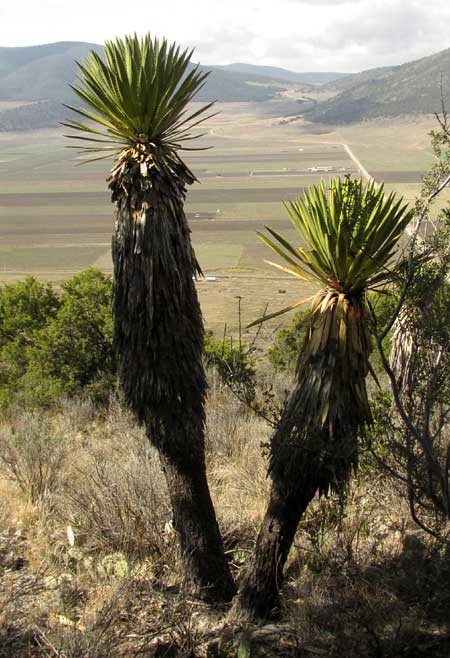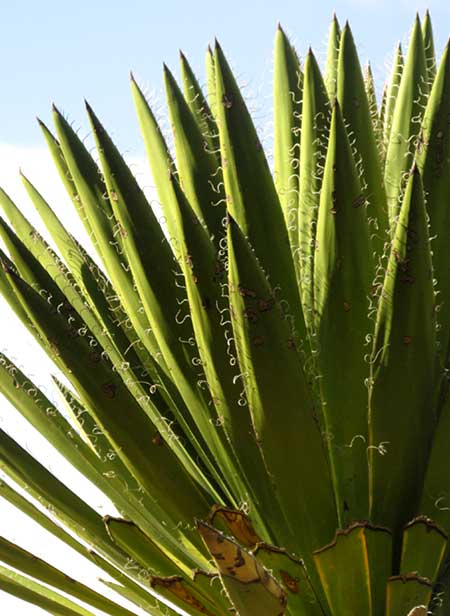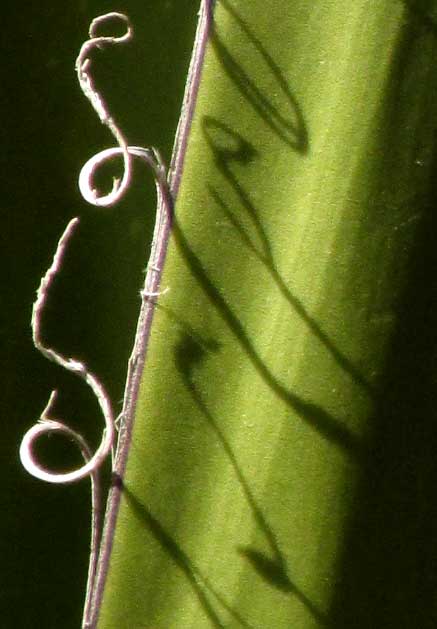Excerpts from Jim Conrad's
Naturalist Newsletter
from the June 21, 2018 Newsletter with notes from a camping trip in early April in the mountains east of Saltillo, Coahuila, Northeastern MÉXICO
GIANT SPANISH DAGGER
Several weeks ago, on April 5th, in the mountains east of Saltillo, Coahuila, northeastern Mexico, I started out hiking on a valley floor, and climbed a small limestone mountain that was grassy and scrubby at its base, but forested on top. At the top, at ±7000 feet in elevation (2100m), the forest was composed nearly entirely of widely spaced, low growing, somewhat gnarly pines and junipers, but here and there tree-size yucca plants appeared. Below, you can see a couple, with the valley in the background, along with mountains that are grassy below but forested above:

Twelve yucca species -- species of the genus Yucca of the Agave or Asparagus Family -- are listed for Coahuila state, so since the yuccas on this mountain weren't flowering, I wondered if I'd be able to identify them. When I looked closer at the plants' blades, however, I saw I might have a chance. Below, you can see why:

For one thing, the blades are considerably shorter and broader than leaves on most other yucca species. The most interesting field mark, though, was how the blades' margins bore stiff, white, curly, hair-like items. Those were so distinctive that I took the close-up shown below:

You can see that they're not really hairs. LH Bailey in his Manual of Cultivated Plants refers to them as "fairly coarse curly marginal fibers," indicating that they don't really have a good name. I'm guessing that they're an adaptation of this species for wicking moisture from the air, which on these mountaintops often manifests as cloud.
In the end, the blades' stubby shape and their curly marginal fibers was enough to peg this yucca as YUCCA CARNEROSANA, a species endemic just to six arid northeastern Mexico states, and the Big Bend National Park area of southwestern Texas. It's widely planted in gardens in other countries, so it's graced with some English names, the most common maybe being Giant Spanish Dagger. In Texas we've met a flowering yucca just called Spanish Dagger, and you enjoy comparing our present species with that one -- noticing the other's more typical longer, narrower blades -- and being reminded of what yucca flowers are like, at www.backyardnature.net/n/w/yucca-tr.htm
Another mountaintop yucca species with similar filamentous fibers on its blades' margins occurs in the area, Yucca filifera, but its blades are more slender, and likes higher elevations than Yucca carnerosana, though in some parts, where the forest is oak/pine instead of pine/juniper, they mingle.
The filamentous marginal fibers on this species' blades reminds us that yucca blades are very stiff because they contain tough fibers. In north-central Mexico, as with the Henequen agave in the Yucatan, traditionally this yucca's blades have been harvested and the fibers removed for making ropes. Stiff, dry fibers from the leaves are known as ixtle and have been sold for use in the brush-making industry. People who gather ixtle are known as ixtleros, and the whole region where ixtleros gather the fiber is known as the Zona Ixtlera. (Ixtle fibre is also made from leaves of the Lechugilla Agave and the big bromeliad, Achemea magdalenae.)